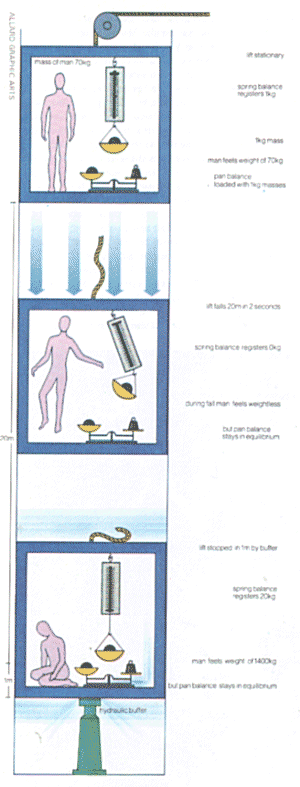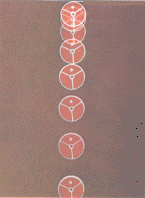
 |
How it works : Mass and Weight |
MASS and WEIGHT
 |
Brief periods of weightlessness are possible in aircraft flying in parabolic paths. The human body is relatively unaffected if fully exercised- three Skylab astronauts spent a record 84 days in free fall at the beginning of 1974 without any ill effects. |
Mass (more correctly, inertial mass) is an intrinsic property of all matter and is a measure of its resistance to being accelerated by a force (see FIELD and FORCES). A cannonball, for example, requires a much greater force to set it rolling at a particular speed than does a football and this is as true on the Moon or in space as it is on the Earth.
The weight of an object is a more familiar concept to most people. It is the force which gravity exerts on the object and as such its magnitude can be found from Newton's second law of motion (see NEWTON'S LAWS). This states that the force on an object is equal to its mass multiplied by the acceleration this force produces. In a gravitational field therefore, the weight of an object is equal to its mass multiplied by the acceleration due to gravity. On Earth, the acceleration due to gravity (given the symbol g) is 9.81 metres per second per second (approximately 32 feet per second per second)-that is, every second the speed of a falling body increases by 9.81 m/s or 32 ft/s. On the Moon,the acceleration due to gravity is only one-sixth that on the Earth and consequently objects on the Moon weigh only one-sixth of their weight on the Earth. As weight is the force exerted by gravity on an object, it is also equal to the force one must use to lift such an object against gravity.
Weightlessness
It is possible for an object to have no weight. A man in a freely falling
lift, for example, is weightless. He feels no force between himself
and the lift floor because both are accelerating downwards at exactly the
same rate. The period of weightlessness achieved in this way is necessarily
quite short, for even in five seconds the man will have fallen 400 ft (120
m).
Trainee astronauts have been subjected to weightless conditions for several minutes by flying an aeroplane on a parabolic trajectory the path in which a stone moves when thrown upwards. The pilot ensures that the aeroplane (and astronaut) moves along a parabolic path-as it travels upwards it is decelerating (negative acceleration) at 9.81 m/s2 (32 ft/s2), it eventually reaches its topmost point (the apogee) where its upwards velocity is zero, and then continues to accelerate downwards like the free falling lift. At all points along the journey the aeroplane undergoes a downwards acting acceleration and the astronaut experiences weightlessness.
 |
Mass in an unchanging property of matter, but weight depends on the environment. A man with a mass of 70 kg at rest on the Earth's surface feels a weight of 70 kg. If he is in a falling lift, he feels weightless until the car hits the bottom, when the abrupt deceleration causes a large temporary increase in his weight. All the time, however, his mass remains unchanged. Note that a spring balance measures weight, but a pan balance mass. |
An astronaut orbiting the Earth in a satellite also experiences weightlessness. In this situation the CENTRIFUGAL force acting on the satellite and astronaut through their circular motion about the Earth counterbalances the Earth's gravitational forces on them. Also at such points in space which are remote from massive bodies, the gravitational forces are so weak that all objects are virtually weightless
Units of mass and weight
Mass is a primary property of matter (see DIMENSIONS), that is, the units
of mass are fundamental and cannot be reduced to other (more fundamental)
units. Typical units are pounds, ounces, grammes, kilogrammes, tons and tonnes.
In the metric system the unit of mass is the International Prototype Kilogramme,
a block of platinum-iridium alloy, kept at the International Bureau of Weights
and Measures at Sévres (near Paris).
Because force equals mass times acceleration, the dimensions of force (and therefore weight) are [mass] x [acceleration] which can be written as [M][L][T-2] where M is mass, L is length and T is time. In the MKS (metre-kilogramme-second) system of units, force is measured in newtons, defined as the force required to move a kilogramme mass with an acceleration of one metre per second per second. It therefore has the units kg m/s2.
For practical reasons it is often more conventional to use the weight of a standard mass within the standard gravitational field, g. That mass is then suffixed with the word 'weight' as in the 'kilogramme weight' (kg wt). The kg wt is approximately 9.81 newtons (9.87 N) because g is 9.81 m/s2 and the newton is defined as the force producing an acceleration of 1 m/s2 on 1 kg mass. As g varies slightly over the Earth's surface, the kg wt also undergoes slight variations according to the position where it is being measured.
 |
| Below: a stroboscopic picture of a disc sliding down a tilted air table. The regular strobe flashes show the rate of acceleration of the disc under the force of gravity. |
Balances
A spring balance measures the weight of an object by opposing the
force of gravity with the force of an extended spring. As such, its readings
will vary from place to place according to the variations in gravity.
The beam balance, on the other hand, measures mass. The beam is balanced when the force of gravity on the object equals that on the combination of standard mass (unfortunately called 'weights') in the other scale pan. Because the acceleration due to gravity is the same at both ends of the beam, the masses must also be equal. Mere, the actual value of g is unimportant- as long as it is not zero.
Inertial and gravitational mass
The discussion of weight relies on the fact that the acceleration due
to gravity is the same for all objects, regardless of their masses. This
principle-sometimes known as the equivalence of inertial and gravitational
mass-was first demonstrated by Galileo. He was supposed to have
dropped two balls of different masses from the top
of the leaning tower of Pisa. They hit the round simultaneously. It is
now known to be true to better than one part in a hundred thousand million,
and EINSTEIN took this equivalence as the starting
point in his General Theory of RELATIVITY to
deduce his theory of gravity.
This equivalence could be of practical use in future space stations. By spinning the station quite slowly, an apparent gravity field will be set up towards the outside of the station, decreasing to zero at the centre of rotation.
Reproduced from HOW IT WORKS p1461